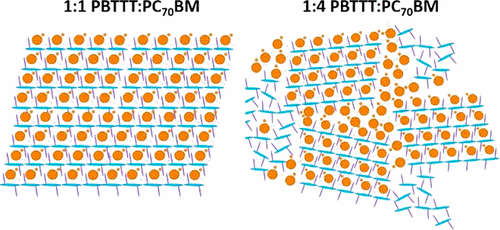当前位置:
X-MOL 学术
›
J. Phys. Chem. C
›
论文详情
Our official English website, www.x-mol.net, welcomes your
feedback! (Note: you will need to create a separate account there.)
Impact of Fullerene Intercalation on Structural and Thermal Properties of Organic Photovoltaic Blends
The Journal of Physical Chemistry C ( IF 3.3 ) Pub Date : 2017-09-19 00:00:00 , DOI: 10.1021/acs.jpcc.7b05893 Jessica Wade 1 , Sebastian Wood 1, 2 , Elisa Collado-Fregoso 3, 4 , Martin Heeney 3 , James Durrant 3 , Ji-Seon Kim 1
The Journal of Physical Chemistry C ( IF 3.3 ) Pub Date : 2017-09-19 00:00:00 , DOI: 10.1021/acs.jpcc.7b05893 Jessica Wade 1 , Sebastian Wood 1, 2 , Elisa Collado-Fregoso 3, 4 , Martin Heeney 3 , James Durrant 3 , Ji-Seon Kim 1
Affiliation

|
The performance of organic photovoltaic blend devices is critically dependent on the polymer:fullerene interface. These interfaces are expected to impact the structural and thermal properties of the polymer with regards to the conjugated backbone planarity and transition temperatures during annealing/cooling processes. Here, we report the impact of fullerene intercalation on structural and thermal properties of poly(2,5-bis(3-tetradecylthiophen-2-yl)thieno[3,2-b]thiophene (PBTTT), a highly stable material known to exhibit liquid crystalline behavior. We undertake a detailed systematic study of the extent of intercalation in the PBTTT:fullerene blend, considering the use of four different fullerene derivatives and also varying the loading ratios. Resonant Raman spectroscopy allows direct observation of the interface morphology in situ during controlled heating and cooling. We find that small fullerene molecules readily intercalate into PBTTT crystallites, resulting in a planarization of the polymer backbone, but high fullerene loading ratios or larger fullerenes result in nonintercalated domains. During cooling from melt, nonintercalated blend films are found to return to their original morphology and reproduce all thermal transitions on cooling with minimal hysteresis. Intercalated blend films show significant hysteresis on cooling due to the crystallized fullerene attempting to reintercalate. The strongest hysteresis is for intercalated blend films with excess fullerene loading ratio, which form a distinct nanoribbon morphology and exhibit a reduced geminate recombination rate. These results reveal that careful consideration should be taken during device fabrication, as postdeposition thermal treatments significantly impact the charge generation and recombination dynamics.
中文翻译:

富勒烯插层对有机光伏共混物结构和热性能的影响
有机光伏共混器件的性能关键取决于聚合物:富勒烯界面。就退火/冷却过程中的共轭骨架平面度和转变温度而言,这些界面有望影响聚合物的结构和热性能。在这里,我们报告富勒烯插层对聚(2,5-双(3-十四烷基噻吩-2-基)噻吩并[3,2- b]噻吩(PBTTT),一种高度稳定的材料,已知具有液晶行为。我们考虑到使用四种不同的富勒烯衍生物并改变负载比,对PBTTT:富勒烯共混物中的嵌入程度进行了详细的系统研究。共振拉曼光谱允许在受控的加热和冷却过程中直接观察界面形态。我们发现,较小的富勒烯分子易于插入PBTTT晶体中,导致聚合物主链的平面化,但是较高的富勒烯负载率或较大的富勒烯导致非插入结构域。在从熔体冷却的过程中,发现非插层共混膜会恢复其原始形态,并在冷却时以最小的滞后现象复制所有的热转变。由于结晶的富勒烯试图重新嵌入,所以嵌入的共混膜在冷却时显示出明显的滞后。最强的磁滞现象是富勒烯负载率过高的插层共混膜,形成明显的纳米带形态并降低了叠合率。这些结果表明,在器件制造期间应认真考虑,因为沉积后热处理会严重影响电荷的产生和复合动力学。
更新日期:2017-09-20
中文翻译:

富勒烯插层对有机光伏共混物结构和热性能的影响
有机光伏共混器件的性能关键取决于聚合物:富勒烯界面。就退火/冷却过程中的共轭骨架平面度和转变温度而言,这些界面有望影响聚合物的结构和热性能。在这里,我们报告富勒烯插层对聚(2,5-双(3-十四烷基噻吩-2-基)噻吩并[3,2- b]噻吩(PBTTT),一种高度稳定的材料,已知具有液晶行为。我们考虑到使用四种不同的富勒烯衍生物并改变负载比,对PBTTT:富勒烯共混物中的嵌入程度进行了详细的系统研究。共振拉曼光谱允许在受控的加热和冷却过程中直接观察界面形态。我们发现,较小的富勒烯分子易于插入PBTTT晶体中,导致聚合物主链的平面化,但是较高的富勒烯负载率或较大的富勒烯导致非插入结构域。在从熔体冷却的过程中,发现非插层共混膜会恢复其原始形态,并在冷却时以最小的滞后现象复制所有的热转变。由于结晶的富勒烯试图重新嵌入,所以嵌入的共混膜在冷却时显示出明显的滞后。最强的磁滞现象是富勒烯负载率过高的插层共混膜,形成明显的纳米带形态并降低了叠合率。这些结果表明,在器件制造期间应认真考虑,因为沉积后热处理会严重影响电荷的产生和复合动力学。










































 京公网安备 11010802027423号
京公网安备 11010802027423号